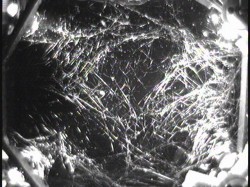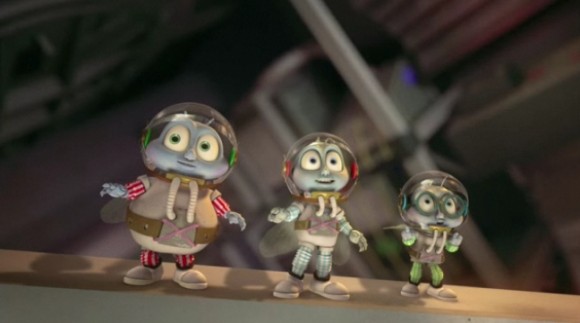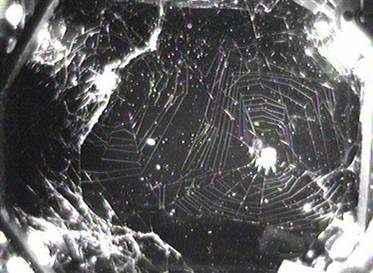[/caption]The educational experiment currently being carried out on the space station has just returned a surprise result. It would appear the two web-weaving spiders being studied have turned their fortunes around – they have scrapped their aimless 3D mess of silk and started to create the symmetrical 2D webs more commonly seen on Earth. The experiment started off a little precarious as one of the spiders went AWOL, but it would appear the pair are back and better than ever, spinning picture perfect spider webs.
This experiment, currently being studied by hundreds of K-12 students in the USA, is one of the payloads of the STS-126 shuttle mission to the International Space Station (ISS), dubbed the “home improvement mission.” Not to be outdone by the space walking astronauts, the little arachnid ISS passengers have decided to do some home improvements of their own…
“While y’all have been busy doing your extreme makeover, our spiders have done an extreme makeover and have torn down their first web and have made another one,” flight controllers informed the ISS crew.
“I thought we were your main entertainment, but I guess we’ve been taken over by spiders,” Michael Fincke, space station commander, said in response.

However, it looks like that was just the adjustment period. On Thursday, mission control noticed the web and notified the crew to take a closer look. “We noticed the spiders’ made a symmetrical web,” Fincke radioed to Mission Control on Friday. “It looks beautiful.”
This striking turn-around by the spiders will be of great interest to biologists and students alike. Although it was interesting to study how different forms of life adapt to conditions in space, I don’t think anyone was predicting such a dramatic change in fortune. I just hope the spider duo get an extra treat for their troubles.
It turns out that the space station crew not only have spiders and butterflies in space to keep them company, they also have a collection of fruit flies to feed to the busy spiders. However, having seen the animated movie “Fly Me to the Moon” in August, we already know how flies adapt to space…

Source: MSNBC


I have been amazed as anyone else. It seems like a classic case of adaptability. But I do wonder now if these spiders build those chaotic webs in certain circumstances … when under stress for example ? No doubt the biologists and nature watchers could give me some answers.
It is a very interesting find indeed!! i am just wondering how far does this adaptability goes?? Can they survive extreme weather conditions like the after effects of an asteroid impact or masses which are thrown off after such an impact?? and so on and so forth….hmmm..looks like one can let imagination wander in this direction too….
Arthropods kick ass.
You are aware that “Arthropods” means all insects, crustaceans, arachnids, etc. together right? Did you mean just arachnid?
At any rate, I for one find the results surprising, I mean – it’s not like natural selection ever “prepared” them for something like lack of gravity.
Does the experiment have some sort of goal? Something they’re supposed to learn? What conclusions can be drawn from this?
Miracles happen, not every thing is going to mess up just because the spiders are not human. Let us enjoy this surprise.
This never surprised me actually, if you look back you will see.
I knew they would adapt pretty quickly, Spiders are used to having “down” in every direction.
Insects tend to live in a very different world to larger animals.
Glad to see they found the other one too!
This is just such a cool idea for an experiment! I was hoping they would weave dodecahedrons or something, but it’s neat to find out that they adapted to weaving normal webs. Make me wonder if bees would be able to produce normal hives, or birds would be able to build normal nests in zero-g. Great article – as always – Ian.
~Nick
This is not a surprise: this is exactly the result obtained on Skylab
over 30 years ago, the chaotic web, followed by the spiders tearing it apart and weaving a good one. If NASA and the experimenters are truly surprised, it’s a sign they have run the
“experiment” without studying prior history. If they are feigning surprise, it’s a phony publicity stunt, not science.
“You are aware that “Arthropods” means all insects, crustaceans, arachnids, etc. together right? Did you mean just arachnid?”
Click on my name. It will send you to one of my pages. Asking me if I was aware is somewhat redundant: the answer is almost always yes, as long as the person asking me isnt from the future.
The biodiversity of life on earth can be described in this way: Arthropods, balance: trace other. There are several macro, and thousands of micro arthropods around you right now. Probably a few living on your body as well. They KICK ASS. I am not that shocked they did well in space, that is just another environment they are waiting to take over.
Are they supposed to stay up there, or will they be going down on the shuttle again?
I’m getting curious as to whether they’ll now have the same trouble adjusting to regular gravity as a astro-/cosmonauts do.
Sili that would be a great thing to study. I suspect their micro-g adaptations are additive, not a replacement of previous instincts. I would guess that they do pretty well back in gravity, perhaps after a day or two of getting used to things.
Maybe we should hire the spiders to run our space program.
Clearly they know how to untangle and deal with a sticky situation.
cool!!!